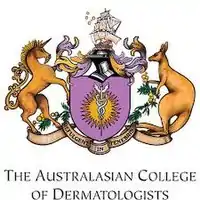Australasian College of Dermatologists
The Australasian College of Dermatologists (ACD) is an accredited specialist medical college comprising medical practitioners with specialist training in dermatology.
 | |
| Abbreviation | ACD |
|---|---|
| Formation | 1967 |
| Legal status | Non-profit |
| Purpose | Education, training, standards and advocacy of dermatologists |
| Headquarters | Sydney |
| Location |
|
Region served | Australia and New Zealand |
Membership | Doctors |
President | Adj A/Prof David Francis |
Staff | 22 |
| Website | http:// www.dermcoll.edu.au/ |
About
The Australasian College of Dermatologists was founded in 1967. There are currently over 550 Fellows of the College[1] and over 100 registrars (doctors in training).
The ACD is the only recognised body for training as a dermatologist in Australia.[2][3][4][5] It is a member of the Council of Presidents of Medical Colleges.[6]
Australia and New Zealand have relatively high rates of both melanoma and non-melanoma skin cancer, thought to be due to combinations of fair-skinned population, temperate to subtropical locations and outdoor lifestyle with high sun exposure.[7]
History
Traditionally dermatology training was undertaken as part of General Physician training. In the 1960s, dermatologists in NSW and Victoria thought that a separate College was warranted.
The College was inaugurated as the Australian College of Dermatologists on 1 May 1967.[8]
Fellowship of the College
Candidates complete a four-year Fellowship to be admitted as a Fellow of the ACD.
Dermatologists are medical specialists and should be differentiated from primary-care doctors who work at "skin screening" clinics. All specialist dermatologists have a very high level of training and practice experience in their field. There is less regulation of primary-care skin clinics where quality and experience may therefore vary.
In New Zealand, advanced training in dermatology can be done through the Royal Australasian College of Physicians.[9]
Publications
The ACD publishes The Australasian Journal of Dermatology[10] and position statements (e.g. "Sun Protection and Sunscreen").[11]
References
- "ACD Website". Retrieved 2 June 2020.
- "Australasian College of Dermatologists". www.healthdirect.gov.au. Healthdirect. 2 March 2020. Retrieved 27 June 2020.
- "Dermatology". Australian Medical Association. 17 February 2016. Retrieved 27 June 2020.
- Australian Government Department of Health and Ageing, Health Workforce Division. "Australian College of Dermatologists". Australian Government Department of Health and Ageing. Retrieved 27 June 2020.
- "How to Become a Dermatologist in Australia". Marie Claire. Retrieved 27 June 2020.
- "Our Members". cpmc.edu.au. Council of Presidents of Medical Colleges. Retrieved 27 June 2020.
- "Skin cancer incidence and mortality – Skin Cancer Statistics and Issues". wiki.cancer.org.au.
- "It started from scratch" (PDF). www.dermcoll.edu.au. Retrieved 7 June 2020.
- "The Royal Australasian College of Physicians". The Royal Australasian College of Physicians. Retrieved 27 June 2020.
- "Australasian Journal of Dermatology". Wiley Online Library. Wiley. Retrieved 27 June 2020.
- "Position statement" (PDF). www.dermcoll.edu.au. 2017. Retrieved 7 June 2020.